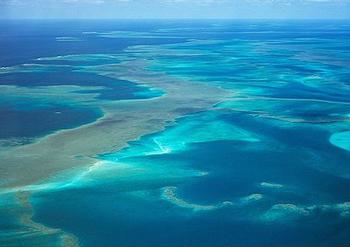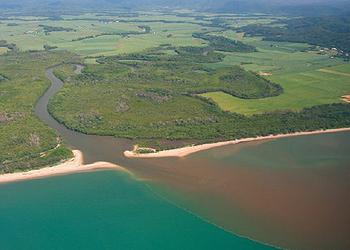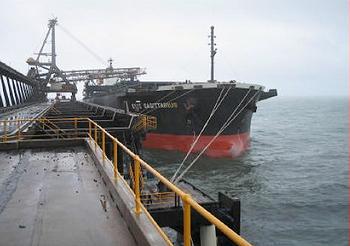Ministers Ignore Industrial Threats to Great Barrier Reef - Juli 10, 2013
BRISBANE, Queensland, Australia, July 10, 2013 (ENS) – The Australian and Queensland governments today pledged to protect the world’s longest coral reef under a new plan endorsed at the Great Barrier Reef Ministerial Forum in Brisbane. But environmental advocates warn the ministers are ignoring alarm bells about industrial development rung by the United Nations. - Juli 10, 2013
The 2013 Reef Water Quality Protection Plan is designed to guide initiatives to ensure that runoff from agriculture has no detrimental impact on the health and resilience of the Great Barrier Reef.

Cockatoo Reef in the Pompey Reefs Complex (Photo courtesy Queensland Greens)
Over the next five years, the Australian government will invest A$200 million through the Caring for our Country Reef Rescue initiative, while the Queensland government will invest A$175 million for a range of strategic reef programs, including new industry-led best management practice programs, the ministers said.
But the nonprofit Australian Marine Conservation Society says state and federal ministers missed an opportunity to address the impacts of rapid industrial development along the Queensland coast on the Great Barrier Reef, a UNESCO World Heritage Site.
AMCS Great Barrier Reef Campaign Director Felicity Wishart said the ministers had ignored the recommendations of the UNESCO World Heritage Committee at its annual meeting in June to stop work now on all industrial developments and stop dumping dredging material in World Heritage areas.
“After the high level of concern raised by the World Heritage Committee about the threat of industrial development of the Reef, we are disappointed that the Ministerial Forum has ignored this emerging threat,” Wishart said.
Australia has told the World Heritage Committee that currently 43 proposed developments are being assessed for potential impacts on the property’s Outstanding Universal Value.
“Today’s Ministerial Council is another missed opportunity,” Wishart said. “While we commend initiatives to improve the water quality running on to the reef, we do not want those efforts overshadowed by millions of tonnes of dredging and dumping and a shipping superhighway.”
“The Queensland Government is fast-tracking approvals for increased port, rail and mine developments which will threaten the reef. The federal government appears to be backing them,” Wishart said. “Australians should be very concerned about the health of the reef. Planned mega-ports and a shipping super-highway just over the horizon will not help.”
Fight for the Reef today launched their Brisbane TV ad campaign to raise the issue of rapid industrialization on the Great Barrier Reef to Brisbane residents who may be unaware of the extent of the threat.
“Minister Butler will make a decision by early August on whether he will approve three million cubic metres of dredging at Abbot Point, just 50 kilometers (30 miles) from the Whitsundays. The current proposal will see the seafloor torn up and the sediment dumped in the reef’s waters,” said Wishart. “These are critical issues. They have the capacity to affect local tourism to an internationally valued destination.”
Federal Minister for the Environment Mark Butler said the Reef Water Quality Protection Plan has been in place for the past 10 years and has delivered positive results and improved reef health.
“As demonstrated by the 2011 Great Barrier Reef Report Card also released today, solid progress has been made towards key targets including land management practice, with 34 percent of sugarcane growers, 17 percent of graziers and 25 percent of horticulture producers adopting improved management practices,” Butler said.
“As a result, we have seen nitrogen levels reduce by seven percent, pesticides by 15 percent and sediment by six percent while dissolved nitrogen, the key pollutant of concern due to its influence on crown-of-thorns starfish outbreaks, also reduced by 13 percent.”
Queensland Minister for Environment Andrew Powell said the primary focus of the 2013 Reef Water Quality Protection Plan continues to be on addressing diffuse source pollution from broadscale land use.

Runoff entering the Great Barrier Reef lagoon north of Mossman, Queensland (Photo courtesy Queensland Department of Agriculture Fisheries and Forestry)
“Credit must go to the many landholders who are improving their land management practices and playing their part in protecting the reef,” Powell said.
“We are working closely with industry, landholders, natural resource management bodies and community groups to accelerate the uptake of practices that maximize reef water quality while maintaining and enhancing profitability and environmental performance,” said Powell. “Ultimately, we need a healthy and resilient reef that supports world class tourism and other industries.”
The ministers say the 2013 Reef Water Quality Protection Plan has been guided by a scientific consensus statement developed by a multidisciplinary group of scientists, with oversight from the Reef Plan Independent Science Panel.
The consensus is that reef ecosystems are showing declining trends in condition due to poor water quality, cumulative impacts of climate change and increasing intensity of extreme weather events.
“In spite of solid improvement, data tells us that poor water quality is continuing to have a detrimental effect on reef health,” Butler said. “To secure the resilience of the Great Barrier Reef it is critical that we build on the momentum of the previous Reef Plan with a focus on improving water quality and land management practices through ambitious but achievable targets.”
The World Heritage Centre and its advisor on natural sites, the International Union for the Conservation of Nature, IUCN, consider that some of the actions undertaken by Australia appear inconsistent with the requests made by the World Heritage Committee. “While the State Party has not approved port developments outside existing major port areas, there is also no clear commitment toward limiting port development to existing port areas,” they said after the June meeting of the World Heritage Committee.
They recommend that the Committee consider the Great Barrier Reef for inscription on the List of World Heritage in Danger at its 38th session in 2014 in the absence of a firm and demonstrable commitment on these priority issues by Australia.
The ministers also received the 2011 Great Barrier Reef Report Card, which shows that “management change and water quality improvements are on a positive trajectory,” but blames extreme weather events for a decline in the marine environment “from moderate to poor overall in 2010–2011.”
Extreme weather events in 2010-2011 included high rainfall causing much higher than average discharge for most rivers, especially the Fitzroy and Proserpine Rivers. In addition, the Report Card shows, Tropical Cyclone Yasi passed across the reef in early 2011, causing damage to seagrass meadows and reefs from Cooktown to Mackay.

Loading a ship with coal at the Abbot Point wharf (Photo courtesy Ports Corp. of Queensland)
For more information about the 2013 Reef Water Quality Protection Plan and the 2011 Great Barrier Reef Report Card, visitwww.reefplan.qld.gov.au
The Queensland government is developing a Great Barrier Reef Ports Strategy based on the fact that the reef is recognized as a multiple use area that supports a range of activities and industries such as tourism, fishing, boating and shipping. Ports adjacent to the reef support a vast amount of economic activity including tourism and
commercial fishing.
The Great Barrier Reef Ports Strategy acknowledges the importance of the cruise shipping industry to the Queensland economy. In 2011-12 time period, 239 cruise ships visited Queensland ports, contributing A$600 million to the state’s economy and supporting more than 2,000 jobs.
The Great Barrier Reef Ports Strategy is seeking to address the needs of these activities by limiting significant port development to within existing port limits over the next 10 years.
But environmental advocates say that even though it is within existing port limits, the proposed coal export terminal expansion at Abbot Point off central Queensland would damage the reef. North Queensland Bulk Ports Corporation, NQBP, proposes to dredge three million cubic meters of previously undisturbed seabed and dispose of the dredge material within the area of the World Heritage Site to create six new berth pockets and ship apron areas.
The NQBP’s chief executive Brad Fish said, “The Great Barrier Reef is not under threat by proposed port development. … scientific studies independent of the ports show that the major impacts on the GBR’s health are overwhelmingly due to storm damage, the crown of thorns starfish and coral bleaching (as a result of warming water/climate change), not ports or dredging as the current debate would suggest.”
Fish said, “Unlike many groups and individuals who publicly oppose port expansion under the pretext of concern for the Great Barrier Reef, NQBP has over many, many decades invested in robust, comprehensive and peer reviewed research to understand and mitigate potential impacts on the Great Barrier Reef.”
Source: http://ens-newswire.com
Juli 10, 2013

